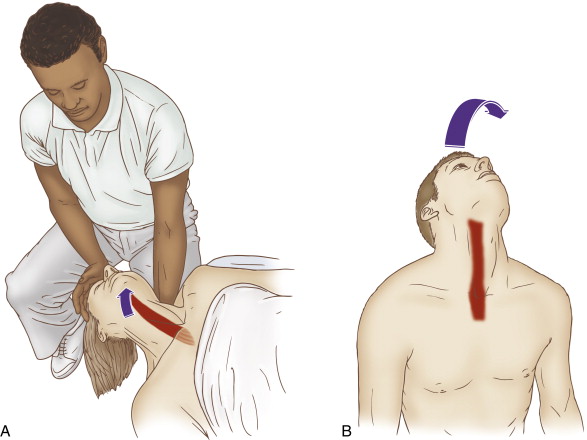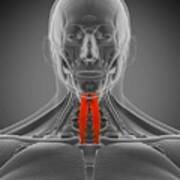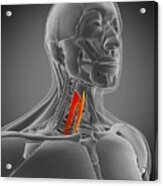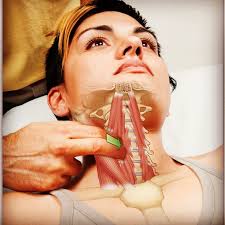

Wondering how did my forward head posture weaken my Longus Colli muscles?
It goes without saying that a forward neck is seemingly “taken for granted” these days.
I personally see most people who work at offices to be hunched forwards. Their head is sliding forward (ever so slightly) that it is sometimes hard to determine whether it is a natural spinal posture or a “cultivated” one.
Forward neck is just an inch or two forward protrusion of your neck. These 2 to 3 inches are usually ignored by our tech-friendly society.
Nonetheless, these 2 or 3 inch forward slide of the head adds a whopping 12 to 40+ pounds of added weight onto your neck.
This added weight either stretches or contracts all those muscles that protect your cervical spine. One such muscle is the deep cervical flexors.
In this article, BestForwardHeadPostureFix shall be discussing how my deep cervical flexors suffered terribly at the hand of my nerd neck.
How did My Forward Head Posture Weaken My Longus Colli Muscles – Article Index:
Introduction: Forward Head Posture and Longus Colli Muscles
- Overview of the impact of forward head posture
- Personal observation and the hidden strain on neck muscles
What Are My Longus Colli Muscles?
- Importance and role of Longus Colli muscles in cervical stability
- Comparison to core muscles and their protective function
What Are the 3 Portions of My Longus Colli Muscles?
- The Vertical Muscle (The Pillar)
- Origin and insertion points
- Functions: Flexing the cervical spine, maintaining posture, lateral flexion, smooth neck movements, and cervical spine health
- The Superior Oblique (The Head Tilter)
- Origin and insertion points
- Functions: Stabilizing the neck, flexion, lateral flexion, rotation, and respiration support
- The Inferior Oblique (The Neck Stabilizer)
- Origin and insertion points
- Functions: Stabilizing the neck, flexion, lateral flexion, rotation, and respiration support
How Did My Forward Head Posture Weaken My Longus Colli Muscles?
- Definition and impact of forward head posture
- Personal reflection on the development of text neck
Impact of My Nerd Neck on My Longus Colli Muscles
- Muscle Fatigue and Weakening:
- Research evidence from the “Journal of Physical Therapy Science”
- Increased Muscle Strain:
- Findings from the “Journal of Bodywork and Movement Therapies”
- Pain and Discomfort:
- Effects of overworked Longus Colli muscles
- Compensatory Muscle Overuse:
- Strain on upper back and shoulder muscles
- Cycle of Dysfunction:
- The difficult cycle of weakening muscles and worsening posture
Important Note: Breaking the Cycle
- Importance of proper posture and targeted exercises
- Evidence from the “International Journal of Environmental Research and Public Health”
- Practical tips for maintaining neck health
FAQs on Longus Colli muscles & Forward Head Tilt
Takeaway
- Summary of the importance of addressing forward head posture
- Benefits of strengthening Longus Colli muscles
- Encouragement to adopt better habits for overall well-being
What are My Longus Colli Muscles?
The Longus Colli muscles are an integral part of the deep cervical flexor muscle groups. These muscles are responsible for holding my head in its proper position.
Without them, I would never be able to maintain a stable head and ensure that my neck and head does not slide forwards. In my opinion, the deep flexor muscles are similar to the “core muscles” of my body.
They help support and protect my neck muscles from all sorts of injuries. Deep flexor muscles also ensure that I am able to twist, shift, move and bend my neck in any direction I wish without any issue.
So, it would not be incorrect to state that my Longus Colli muscles are a part and parcel of my deep cervical flexors.
In my opinion, the Longus Colli is symbolic to the head of the family. While the head of the family makes all efforts to provide and protect for his family, his efforts are usually ignored and often misunderstood.
Nonetheless, despite the lack of spotlight, Longus Colli continues to bear the responsibility of upholding the correct posture of your head.
What are the 3 Portions of My Longus Colli Muscles?
There are three portions of the Longus Colli muscles. These are:
@ superior oblique,
@ the vertical and
@ the inferior oblique.
I term these as the Longus Colli trio.
Each of these three muscles has its own significance and importance in permitting your neck to retain its stability and flexibility.
Let me now walk you through each of these in brief:
The Vertical (The Pillar of Longus Colli)
I popularly terms the “Vertical” muscle group of the Longus Colli as the pillar. It initiates from anterior surface of the top 3 thoracic vertebrae.
During its vertical journey, it also crosses the anterior surface of the 2nd, 3rd and 4th cervical vertebrae. The Vertical muscle of the Longus Colli then enters the anterior surface of the 2nd, 3rd and 4th cervical vertebrae.
What are the Main Functions of the Vertical Muscle?
Here are the main functions:
Flexing the Cervical Spine:
@ Bends the neck forward: The vertical muscle of Longus colli primarily helps in flexing the cervical spine, which means it allows you to bend your neck forward.
This movement is essential for activities such as reading, writing, and looking down at objects.
Maintaining Neck Posture and Stability:
@ Supports the cervical vertebrae: This muscle provides support to the cervical vertebrae, the bones that form the neck portion of the spine.
By doing so, it helps in maintaining the alignment and proper positioning of these vertebrae.
@ Helps maintain head posture: By supporting the cervical vertebrae, the vertical muscle of Longus colli plays a crucial role in keeping your head upright and stable.
This is important for maintaining a balanced and erect posture, especially during prolonged periods of sitting or standing.
Assisting in Lateral Flexion:
@ Allows the neck to bend sideways slightly: Besides flexing the neck forward, the vertical muscle of Longus colli also aids in lateral flexion.
This means it helps you bend your neck to the side, albeit to a lesser extent compared to other muscles.
This movement is useful for activities such as tilting your head to listen or observe something from a different angle.
Facilitating Smooth Neck Movements:
@ Essential for various daily activities: The coordinated action of the vertical muscle of Longus colli with other neck muscles ensures smooth and controlled neck movements.
This is crucial for performing various daily activities like looking down, turning your head, and maintaining a stable gaze.
Contributing to Cervical Spine Health:
@ Plays a crucial role in overall neck and spine well-being: By flexing the cervical spine, maintaining posture, and assisting in lateral movements, the vertical muscle of Longus colli contributes significantly to the overall health of the cervical spine.
Proper functioning of this muscle helps prevent neck pain, strain, and potential injuries, thus supporting overall neck and spinal health.
The Superior Oblique (The Head Tilter)
The second muscle portion of the Longus Colli is the Superior Oblique.
It originates from the anterior tubercles of the transverse processes of the third to fifth cervical vertebrae and inserts into the anterior arch of the atlas (the first cervical vertebra).
The reason why I termed the Superior Oblique as a head tilter is because it holds your head in place and allows it to tilt in a slow and steady manner.
Basically, it holds your head tightly while permitting you to descend in a graceful manner.
What are the Main Functions of the Superior Oblique Muscle?
Here are the main functions in brief:
Stabilizing the Neck:
@ Maintains Posture: The superior oblique muscle helps stabilize the cervical spine, which is essential for maintaining good posture and keeping your head upright.
@ Supports Movement: It provides support during neck movements, ensuring that your head stays balanced as you turn or tilt.
Flexion of the Neck:
@ Bending Forward: This muscle assists in flexing the neck, allowing you to bend your head forward. It is key for activities like reading a book or looking down at your phone.
Lateral Flexion:
@ Bending Sideways: The superior oblique muscle aids in the lateral flexion of the neck, which is the movement that lets you tilt your head to the side. This function is essential for actions like leaning your head on your hand.
Assisting in Rotation:
@ Turning the Head: It also plays a role in rotating the neck, allowing you to turn your head from side to side. This movement is crucial for activities like checking your blind spot while driving.
Stabilizing During Respiration:
@Breathing Support: By stabilizing the cervical spine, the superior oblique muscle indirectly supports the respiratory process, making breathing easier and more efficient.
Important Tip:
So, next time you’re nodding, tilting, or turning your head, remember the superior oblique muscle’s hard work in the Longus Colli group.
It is all about keeping your neck movements smooth and your head stable!
The Inferior Oblique (The Neck Stabilizer)
The last and final muscle group of the Longus Colli is the Inferior Oblique. Please do not get mistaken by its name. It is named inferior but it has all the qualities of a superior muscle group.
The inferior oblique is the stabilizing force behind your head and neck movements.
The inferior oblique starts from the anterior surface of the bodies of the first two or three thoracic vertebrae and the lower cervical vertebrae.
It inserts into the transverse processes of the fifth and sixth cervical vertebrae. Its main job is to help flex the neck and stabilize the cervical spine.
What are the Main Functions of the Inferior Oblique Muscle?
Let me walk you through these in brief:
Stabilizing the Neck:
@ Maintains Posture: The inferior oblique muscle plays a vital role in stabilizing the cervical spine, which is essential for maintaining good posture and keeping your head upright.
@ Supports Movement: It helps stabilize the neck during various movements, ensuring your head stays balanced as you move.
Flexion of the Neck:
@ Bending Forward: This muscle assists in flexing the neck, allowing you to bend your head forward.
It’s crucial for activities like reading a book or looking down at your phone.
Lateral Flexion:
@ Bending Sideways: The inferior oblique muscle aids in the lateral flexion of the neck, which is the movement that lets you tilt your head to the side.
This function is essential for actions like leaning your head on your hand.
Assisting in Rotation:
@ Turning the Head: It also plays a role in rotating the neck, allowing you to turn your head from side to side.
This movement is vital for activities like checking your blind spot while driving.
Stabilizing During Respiration:
Breathing Support: By stabilizing the cervical spine, the inferior oblique muscle indirectly supports the respiratory process, making breathing easier and more efficient.
Tip of the Day:
So, the next time you’re nodding, tilting, or turning your head, remember the hard work of the inferior oblique muscle in the Longus Colli group.
It’s all about keeping your neck movements smooth and your head stable!
How did my Forward Head Posture Weaken my Longus Colli Muscles?
I have already discussed what is meant by forward head posture in the first few paragraphs of this article.
Now, I do not wish to digress from the topic and discuss how I developed a text neck.
I wish to get on top of the topic and reveal how my forward head caused immense damage to my Longus Colli muscles. So, here we go:
Impact of My Nerd Neck on My Longus Colli Muscles
The Longus Colli muscles are essential for stabilizing and flexing your cervical spine.
When your head is constantly jutted forward, these muscles are put under continuous strain.
Here are the key side effects of this posture:
Muscle Fatigue and Weakening:
Research published in the “Journal of Physical Therapy Science” shows that forward head posture significantly increases the strain on the Longus Colli muscles.
This persistent strain leads to muscle fatigue and weakening over time.
Increased Muscle Strain:
The constant forward position forces the Longus Colli muscles to work harder to support the head, which can cause chronic strain.
This is backed by findings in the “Journal of Bodywork and Movement Therapies,” which observed reduced strength and endurance in these muscles due to forward head posture.
Pain and Discomfort:
As these muscles become fatigued and weakened, you may experience pain and discomfort in the neck.
The overworked Longus Colli muscles can lead to a stiff and sore neck, making everyday activities more challenging.
Compensatory Muscle Overuse:
When the Longus Colli muscles weaken, other muscles in your upper back and shoulders compensate for the lost stability.
This compensatory action can cause additional strain and discomfort in those areas.
Cycle of Dysfunction:
The weakening of the Longus Colli muscles can lead to a cycle of dysfunction. As they weaken, your posture may worsen, causing further strain and discomfort. This cycle can be difficult to break without targeted intervention.
Important Note:
To sum up, forward head posture can lead to significant issues for your Longus Colli muscles, including fatigue, strain, pain, and a cycle of dysfunction.
Addressing this posture and strengthening your neck muscles can help alleviate these side effects and improve your overall well-being.
FAQs on Longus Colli muscles & Forward Head Tilt
Forward head posture (FHP) is a common postural deviation where the head is positioned forward of the body’s center of gravity. This misalignment can significantly impact the cervical spine and associated musculature, particularly the longus colli muscles. Below are five unique frequently asked questions (FAQs) regarding how FHP affects the longus colli muscles:
Q1: How does forward head posture lead to the weakening of the longus colli muscles?
Forward head posture places the head in a forward position, increasing the length of the longus colli muscles. This prolonged elongation can reduce the muscle’s ability to generate force, leading to weakness over time. Additionally, the altered posture may decrease the neural activation of these muscles, further contributing to their weakening.
Q2: What are the functional consequences of weakened longus colli muscles due to forward head posture?
Weakened longus colli muscles can impair the stabilization and flexion of the cervical spine. This dysfunction may result in decreased neck mobility, increased risk of cervical spine injuries, and heightened susceptibility to conditions such as cervicogenic headaches.
Q3: Can forward head posture-induced weakness in the longus colli muscles affect other neck muscles?
Yes, the weakening of the longus colli muscles can lead to compensatory overactivity in other neck muscles, such as the sternocleidomastoid and upper trapezius. This imbalance can cause muscle fatigue, discomfort, and further postural deviations.
Q4: Are there specific symptoms associated with longus colli muscle weakness due to forward head posture?
Individuals with weakened longus colli muscles may experience symptoms such as neck pain, stiffness, reduced range of motion, and difficulty maintaining an upright head position. These symptoms can impact daily activities and overall quality of life.
Q5: What interventions can help strengthen the longus colli muscles affected by forward head posture?
Targeted exercises, such as chin tucks and deep neck flexor strengthening routines, can help activate and strengthen the longus colli muscles. Incorporating these exercises into a regular fitness regimen, along with ergonomic adjustments and posture correction strategies, can effectively address muscle weakness associated with forward head posture.
Understanding the impact of forward head posture on the longus colli muscles is crucial for developing effective strategies to mitigate its adverse effects and promote cervical spine health.
Takeaway
In summary, forward head posture can significantly strain and weaken your Longus Colli muscles, leading to muscle fatigue, chronic strain, tension headaches, and discomfort.
Studies from the “Journal of Physical Therapy Science” and the “Journal of Bodywork and Movement Therapies” highlight that this posture forces the Longus Colli muscles to work harder to support the head, resulting in reduced strength and endurance over time.
This can create a cycle of dysfunction where other muscles in the upper back and shoulders overcompensate, causing additional strain and discomfort.
To break this cycle, it’s crucial to adopt proper posture and engage in targeted exercises like chin tucks and neck flexor endurance training.
Research from the “International Journal of Environmental Research and Public Health” supports that such exercise programs can effectively reduce forward head posture and improve muscle strength.
By addressing your posture and strengthening your neck muscles, you can alleviate these side effects and improve your overall well-being.
So, next time you are at your desk or looking at your phone, remember to keep your head aligned and give those Longus Colli muscles the care they deserve.
Your neck will thank you!
References:


